
There is always plenty to see at NAB and if I liked Las Vegas, I’d surely come more often. But the last time I was here was in 2001 when the show was dubbed the convergence NAB.
I’m going again this year for one main reason: Ultra HD. Sure 4K has been a key topic for at least the last five NABs, but now is different and here’s why.
Gut feelings aren’t very useful in making business decisions, but sometimes, once all evidence has been considered, that’s all you have to go by. Intuitions can even be dangerous when you don’t have enough information, like in 1993 when I advised my cousin not to join an Internet start-up because I “felt” that the Web was going to stay the realm of geeks and early adopters. Thank god he didn’t heed my stupid advice. I also missed the SMS boat with a strong gut feeling that such a barbaric user experience would never make it mainstream. But those were spot decisions made without enough background knowledge let alone understanding of what was really going on under the surface, driving user behaviour. Daniel Kanneman, in his excellent book Thinking Fast and Slow explains how any experts intuitions are mainly bunk anyway.
So I’ll attempt o explain why UHD will be real and will start now with as much argument and fact. I will own up to what is no more than opinion. To prove that this isn’t just consulting BS (yes I admit I’m also a consultant) I’m spending a few grand of my own money and taking 5 days off to go to NAB, which represents over my annual investment as one man band. Now is the time when the industry will really launch UHD, and I want to be there. The table below lists the main reasons given by those who advocate waiting for the time being.
|
Issue |
Description |
Facts |
Opinion |
|
|
for |
against |
|||
| Content creation, postproduction & workflows | 4K content requires powerful hardware and four times the storage space. | Studios already shoot in 4K, as do high-end smartphones. 4K cameras already used to produce several feeds in many studios. | Cost, lack of standards, creates risk of needing to re-invest. | To produce the best possible HD it’s already better to work in UHD then downscale. Be first out of the stalls for UHD deployment. |
| Content availability | Most libraries are not UHD | Anything shot on 70mm film can be re-mastered.
Up-scaling any content improves the HD experience. |
It will take time to reach critical mass of native UHD content. | This is also a chicken and egg situation. Offer and demand will prod each other forwards. Shorter content shelf life means more new content. |
| Colour depth and refresh rates | UHD shows everything better including flaws. 30 fps looks jittery in UHD. | These issues will be addressed irrespective of UHD. HD needs them too. | UHD hardware may not support future HDR and HFR specs. | Can cause legitimate delays. However, improved HD creates awareness of picture quality and fuels desire for UHD. |
| Device readiness | Require more power to decode. | With Moore’s law still in effect this problem will disappear shortly | Impossible to leverage existing hardware in the field | Smartphones shoot 4K that users will want to watch (Apples 5K iMac sets the scene). UHD is a premium feature consumers will pay for. |
| Distribution and Bandwidth | Require 3 to 4 times the HD bandwidth | Fibre and 4G deployments in full swing, HEVC is here | Volumes required for ABR file storage will explode. | Beyond HEVC, a new wave will come (I’l keeps tabs on the buzzing V-Nova). |
| Screen size and viewing distance | To be at least 6 feet away from screen it must be at least 55” | In urban homes shorter viewing distances make sense. | Huge screen sizes are only popular in some markets | As long as consumers perceive benefits they will adapt, they always do. |
I wont dwell in this blog on the benefits of UHD, but unlike with other technical (r)evolutions such as 3D, all content will benefit from UHD. I also see an opportunity for a new kind of video story telling. High resolution content with shorter viewing distances lets different parts of the screen tell a different story depending on how and where you watch. Video can become more immersive. Choosing what part of the screen to watch is almost an interactive experience. Whether 3D technology is present or not will become a technical detail.
All the issues discussed above will benefit from branding, standardization and end-to-end interoperability testing which is why I will be reporting from the launch of the UHD Forum in Vegas. I’ll also look into the UHD alliance which has already launched a consumer facing Web site.
I’ll write a post-NAB blog, so far I intend to meet up with:
- the Ultra HD Forum gang,
- The Ultra HD Alliance (if I find them),
- V-Nova that boasts UHD stream at HD bitrates,
- BBright that offers an entry-level UHD play-out system that simplifies trials,
- Verimatrix, that is launching a new UHD focussed security suite,
- Sony to get a feel of the latest 4K cameras and TVs,
- Please comment if you have other suggestions.
You only need to see UHD twice for it to make sense UHDUHD ;o)
[Update, just got back rather that a new blog here is the word cloud of my impressions walking around the halls and listening to conferences (see my twitter for more details)] : 






